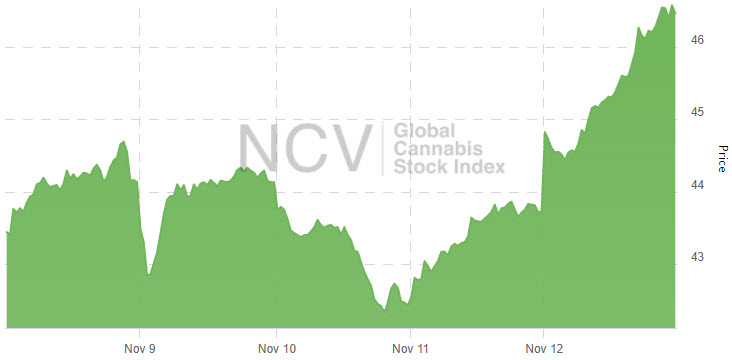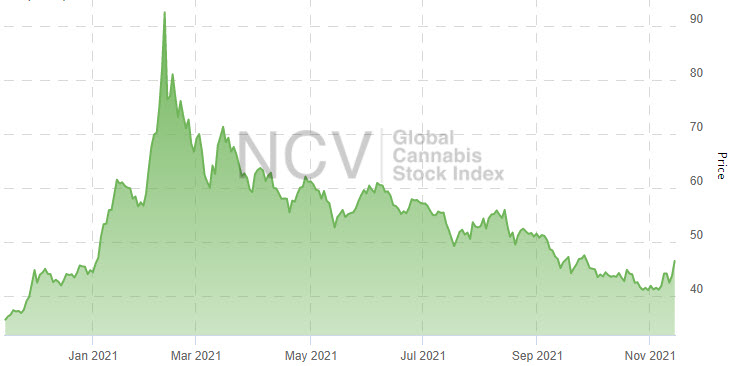Navigate the fast-moving cannabis sector with 420 Investor, a premium service that sends real-time alerts and explanations of the news below and much more.
Summary
- No one was talking about the biggest story of the week: massive inflows into a cannabis ETF.
- Michigan adult-use sales set a record in October.
- Health Canada added 1 new license, leaving the total now at 794.
- 420 Investor model portfolios have gained 18.7-76.2% year-to-date, while the Global Cannabis Stock Index has gained 4.7%.
Review
Approximately $250 million flowed into ETF MSOS during the first four days of the week, only about half of which was deployed into the market through Thursday. Michigan October cannabis sales increased 59% to $163.5 million, with adult-use sales increasing 115% to a record $128.4 million and medical sales declining 19% to $35.2 million.
Health Canada added 1 license, leaving the total at 794, including 9 that are expired, revoked or suspended.
During the week, I shared these insights with subscribers at 420 Investor:
- Previews of Upcoming Financial Reports for Charlotte’s Web, Lowell Farms, Schwazze, TILT Holdings and TPCO Holding
- Preview of Ascend Wellness Q3 Financials
- Previews for Upcoming Financial Reports from Columbia Care, Cresco Labs, GrowGeneration and Trulieve
- Here Is a Way to Potentially Profit from Limited Capital Available to Cannabis Companies
- Previews for Upcoming Financial Reports From Cronos Group, Goodness Growth and Green Thumb Industries
- Cannabis Sub-Sector Review – 11/05/21
- Model Portfolio Composition 11/05/21
Here are some of this week’s highlights for 420 Investor Focus List names:
- AAWH exceeded expectations in Q3, with revenue increasing 13% sequentially to $94 million, but the company predicted that Q4 revenue will decline
- CCHWF Q3 revenue fell a bit short of expectations as it increased 144% to $132 million. The company reduced its outlook for 2021 as well. It opened its third Virginia dispensary.
- CRLBF Q3 revenue increased 3% sequentially to $216 million, just below expectations, as adjusted EBITDA of $56 million was ahead of expectations.
- CRON announced that it delayed its 10-Q filing in order to give the Audit Committee additional time to evaluate a pending impairment charge of $220 million related to its Lord Jones acquisition.
- CURLF announced the pending acquisition of Tryke (Reef Dispensaries) for $286 million, expanding its presence in Arizona, Nevada and Utah. Its Q3 revenue fell short of expectations as it increased 2% sequentially to $317 million with adjusted EBITDA at $71 million, substantially below expectations.
- CWBHF introduced oral sprays with CBD and CBN and also announced its first harvest in Canada
- GDNSF Q3 revenue increased 7% to $13.4 million or 28% if excluding discontinued operations. It reduced its 2022 outlook rather substantially.
- GRWG Q3 revenue increased 111% to $116 million, but the company reduced its 2021 outlook for both revenue and profitability
- GTBIF reported 5% sequential revenue growth in Q3 to $234 million, in line with expectations, and adjusted EBITDA of $81 million, just beneath the consensus
- SMG director Gerald Volas purchased $1 million of stock at $171.52
- TCNNF opened its first West Virginia dispensary and its 108th in Florida.
- TLLTF expanded its relationship with AIRO Brands to offer products in Massachusetts
- TRSSF announced that both its and GAGE’s shareholders have approved the merger
- UGRO boosted its 2021 outlook for revenue and lowered it for EBITDA after reporting Q3 revenue of $18.3 million, up 119%. It signed an agreement with Urban Health Farms as its exclusive partner in Europe for up to 20 vertical farms.
- VFF reported a strong quarter, with overall revenue boosted by its Pure Sunfarms and new CBD division
- VLNCF closed the acquisition of Citizen Stash
- VRNOF announced the acquisitions of 2 dispensaries as well as a cultivator in Connecticut, paying $113 million initially for the cultivation asset.
Market Performance
The Global Cannabis Stock Index scored its second straight weekly gain after nine consecutive declines, increasing 10.9% during the week to 46.46:

The index, which lost 34.1% in 2019 and lost 54.9% in 2018 after gaining 91.8% in 2017 and 88.8% in 2016, was up 5.2% in 2020. It has gained 4.7% in 2021 thus far. It currently includes 42 stocks and ended 2020 at 44.39:
 Model Portfolios
Model Portfolios
420 Investor offers three model portfolios for subscribers, including two that are long-term focused and fully invested with a goal of beating the Global Cannabis Stock Index, 420 Opportunity and 420 Quality. 420 Opportunity ended the week valued at $137,721, up 14.7%. The model portfolio, up 30.7% in 2021, gained 35.6% in 2020 and has increased 175.4% since April 2014 despite the large loss in the index since then. 420 Quality ended the week at $191,672, up 14.8% for the week, and is now up 18.7% in 2021 after gaining 42.8% in 2020. The model was launched in March 2017 targeting long-term investors seeking to invest in leading cannabis stocks with low portfolio turnover and has gained 283.3% since inception compared to the 42.5% decline in the index since then. Flying High, which is focused on swing trades, ended the week valued at $444,724, up 20.2%. The model portfolio gained 52.7% in 2020 and is up 76.2% in 2021, and the return since inception in late 2013 has been 4347%.
Outlook
After a strong rally to begin 2019, the cannabis sector experienced a sharp decline over the next year to unprecedented levels due to several negative developments, including the CannTrust fraud, the surprise termination of Bruce Linton as CEO of Canopy Growth, a disappointing roll-out of legalization in Canada, regulatory confusion in the U.S. regarding CBD and a slow roll-out of legalization in California, the vaping crisis and then financial turmoil and market disruptions due to the COVID-19 pandemic. The sector saw capital available to fund expansion dry up, a situation that continues to leave companies operating with negative cash flow severely challenged, as the availability is limited to stronger operators.
Cannabis stocks overreacted and put in a bottom in March 2020, and benefited from a perception that the industry offers strong growth prospects, something that wasn’t clear then. A big change was that the pandemic caused many regulators to permit previously prohibited types of retail activities, like curbside pickup and delivery. The legal market rapidly capitalized on becoming even more convenient than the illicit market, with the ability to order online. States and municipalities moved to broaden adult-use and medical access. Access to capital improved dramatically, and the leading companies began generating large and rapidly growing revenue and profits.
The strong finish to 2020 continued into 2021 after the Democrats took control of the Senate in early January, but the stocks got way ahead of themselves and have been consolidating since then. In addition to concerns that federal legalization will take a longer time than many have expected, there have been some tough comparisons to year-ago sales levels. Additionally, while several institutions embraced the sector early in the year, there has been a lull in additional interest.
There are several potential catalysts ahead, including the FDA (or Congress) providing clarity on CBD regulation, progress in the Canadian legalization that commenced in October 2018 and that is beginning to include a broader set of products and the continued growth in German and Israeli MMJ and other international markets that have been slow to develop. The adult-use implementations in California and Massachusetts for adult-use were slow to roll out but are beginning to show great improvement. Michigan and Illinois legalized for adult-use at the end of 2019, and these markets are showing strong growth that could encourage other states to legalize. Voters in Arizona, Montana, South Dakota and New Jersey all approved adult-use legalization in November, and Connecticut, New Mexico, New York and Virginia have enacted legalization through the legislative process in 2021.
The big themes ahead are likely to be continued cross-industry investment into the sector and more consolidation in Canada and in the U.S., potential federal regulatory reform (SAFE Banking Act and other more comprehensive legislation, which could eliminate 280E taxation and enable trading on higher exchanges for MSOs as well as the broad usage of credit cards for cannabis purchases), steps to enable cannabis research, the roll out of MMJ in Germany, Mexico and in Australia as well as continued advances in South America and potential adult-use legalization in Israel and Mexico, new legal cannabis implementations in AZ, MT, NJ and SD, and MMJ implementations in AL, WV and VA, possible legalization via the legislatures in DE, FL, MD, MN, NH, PA and RI and implementation of the CT, NM, NY and VT commercial programs in 2022 and VA in 2024.
After bottoming in March 2020, the cannabis sector has been in a new bull market. Many companies are generating substantial revenue and some even a profit, and liquidity is much better. The sector has transitioned away from many legacy penny stocks that had never proven that they had viable businesses towards better capitalized companies, many of which have strong management teams and substantial businesses. The investor base has also transitioned, becoming increasingly more institutional.
